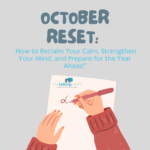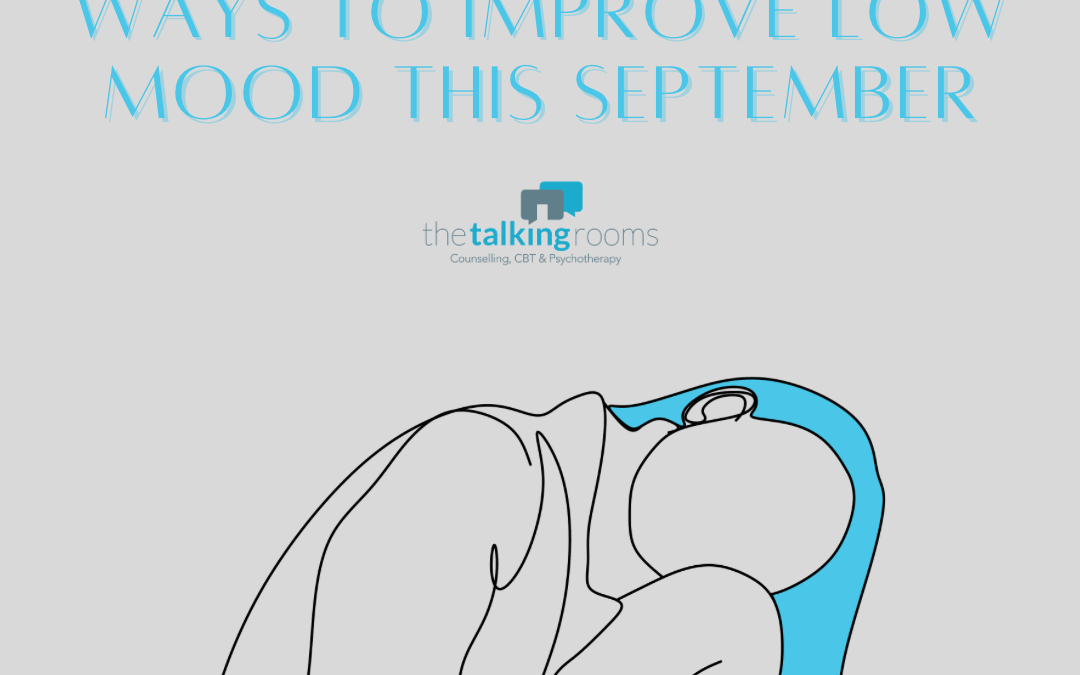
Slow Down to Catch Up: Reconnecting to What Matters Before the Season Shifts
5th August 2025
October Reset: How to Reclaim Your Calm, Strengthen Your Mind, and Prepare for the Year Ahead
1st October 2025Lifting the Fog: Gentle Ways to Improve Low Mood This September
By Nicola Ball, Therapist & Mental Wellness Exper
Introduction – The Weight of September
There’s something about September that carries a mix of energy. On one hand, there’s a fresh start feeling – new routines, sharper mornings, the sense that life is shifting gears after Summer. On the other hand, for many of us, there’s a dip. That familiar heaviness creeps in – motivation feels thin, our mood dips, and we can’t quite shake the sense of being flat.
This is what I call low mood. Not quite depression, but not your usual self either. It’s that foggy, heavy space where everything feels a little harder than it should.
If this sounds familiar, you are not alone. In fact, low mood is one of the most common reasons people seek out therapy. It doesn’t mean you’re broken or weak – it means you’re human. And the good news is, there are practical, compassionate steps you can take to lift yourself out of the fog.
In this blog, I want to explore what low mood really is, why it shows up so strongly at this time of year, and – most importantly – gentle, proven ways to start feeling lighter.
Understanding Low Mood
Low mood is best thought of as a temporary state rather than a fixed condition. It’s different from clinical depression, though if left unaddressed it can sometimes slip into something more serious. Signs of low mood often include:
- Feeling tired or lacking energy.
- Struggling to motivate yourself.
- Irritability or short temper.
- Loss of interest in things you usually enjoy.
- Feeling “flat,” numb, or disconnected.
- A tendency to retreat from others.
The important thing to understand is that low mood is not a character flaw. It’s often your mind and body signalling that something needs attention – whether that’s more rest, a shift in routine, or some emotional release.
September in particular can trigger low mood for several reasons:
- Seasonal change – shorter daylight hours can reduce serotonin and vitamin D.
- Post-summer slump – after holidays or lighter routines, reality can feel heavier.
- Back-to-busy pressure – new school terms, work projects, or financial worries often ramp up.
Knowing this context helps us approach low mood with compassion rather than criticism. It’s not about “snapping out of it.” It’s about giving yourself the right conditions to reset.
The Small Shifts That Help
The cycle of low mood can feel like a trap: the worse we feel, the less we do, and the less we do, the worse we feel. The way out isn’t through giant leaps but through small, consistent shifts. Let’s break these down.
1. Physical Foundations
Your body and mood are inseparable. Supporting your physical wellbeing is the most powerful starting point for lifting low mood.
Sleep
Poor sleep magnifies low mood. Try:
- Keeping a consistent bedtime.
- Reducing screen time before bed.
- Creating a wind-down ritual – journaling, reading, or herbal tea.
Movement
Exercise isn’t about punishment – it’s about energy. Even a 10-minute walk in daylight can boost serotonin and lift your mood. Think gentle: yoga stretches, walking the dog, or dancing in the kitchen (my children do think I am bonkers, and they would be right!) – Just dance like no one is watching.
Nutrition
What you eat impacts your mood more than most people realise.
- Aim for steady blood sugar (fewer big spikes of caffeine and sugar).
- Stay hydrated.
- Add mood-supporting foods: oily fish, nuts, seeds, and leafy greens.
- Be mindful of alcohol – it’s a depressant, and often makes low mood worse.
2. Mental Shifts
Low mood often comes with a harsh inner critic. You might notice thoughts like:
- “What’s wrong with me?”
- “I should be doing more.”
- “I can’t get it together.”
These thoughts don’t just describe low mood – they deepen it.
Instead, try a CBT reframing question:
“What do I need right now?”
This small shift takes you out of judgement and into compassion. Maybe you need rest. Maybe you need connection. Maybe you need structure.
Journaling Prompts for Low Mood
- Today, I feel…
- One thing I can do to care for myself right now is…
- A thought I can release today is…
- A small thing that brought me comfort recently was…
3. Emotional Anchors
When you feel low, it’s easy to withdraw. Yet connection is often the medicine.
Connection
Send one message, make one phone call, or simply sit with someone you trust. Human contact regulates our nervous system.
Acts of Kindness
Helping others, even in tiny ways, boosts dopamine. Hold a door open, compliment someone, or check in on a friend.
Creative Expression
Draw, write, play music, cook – whatever lets your emotions flow without words. Creativity bypasses logic and gives your feelings a healthy outlet.
4. Environmental Support
Your environment shapes your mood more than you realise.
Light
Get outside daily – even on cloudy days. Consider a daylight lamp if mornings feel especially heavy.
Space
Declutter one drawer or corner. A clearer space often creates a clearer mind.
Comfort
Create a “cosy corner” – blankets, candles, calming scents – where you can rest, reflect, or simply breathe.
When to Seek More Support
Sometimes low mood shifts with small changes. Other times, it lingers. If you’ve been feeling persistently low for more than two weeks, or if your mood is impacting your ability to function, please don’t ignore it.
Signs you may need extra support include:
- Struggling to get out of bed most days.
- Persistent negative thoughts about yourself.
- Withdrawing completely from others.
- Using alcohol, food, or other behaviours to cope excessively.
Therapy can be hugely helpful here. CBT, counselling, or group therapy all provide safe spaces to process emotions and build coping tools. At The Talking Rooms, we’ve walked alongside thousands of clients in this exact place – and the transformation is possible.
September Reset – One Intention
Here’s my invitation: Instead of overwhelming yourself with big goals, choose one small intention for September to support your mood.
Examples:
- “I will go outside for 10 minutes every morning.”
- “I will keep a gratitude note each evening.”
- “I will limit social media scrolling before bed.”
Write it down. Stick it on your fridge or bathroom mirror. Let that one small shift carry you.
Closing – Hope and Reconnection
Low mood doesn’t define you. It doesn’t last forever, and it doesn’t mean you’re failing. It means you’re human.
September doesn’t need to be the month you push yourself harder. It can be the month you soften into yourself – the month you treat your body, mind, and heart with gentleness.
If you’ve been feeling flat, I want you to know this: change is possible. One small step at a time, you can lift the fog. And if you need support, we’re here for you at The Talking Rooms.
Book today for your free consultation.



